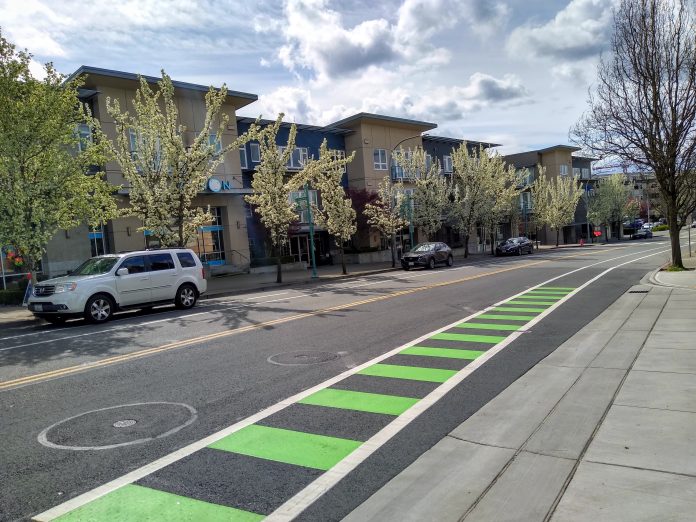
Residents and visitors to Kirkland could see more marked crosswalks along with new and repaired sidewalks if a plan to adopt a new $20 Vehicle License Fee (VLF) moves ahead before the end of 2022 as expected. The Kirkland City Council is currently holding community forums to seek feedback on their proposal to add the dedicated funding source to provide the city with approximately $20 million up front through the use of bonding. Kirkland is one of only a few cities in Washington that have adopted an ordinance permitting its city council to adopt a city-specific car tab but which hasn’t actually enacted it.
Adopting the VLF would allow the city to act more quickly to implement some of the street improvement plans that the city council has already adopted, namely the Safe Routes to School action plan, adopted in 2020, and the Active Transportation plan, adopted earlier this year. Using this source of funding was originally envisioned as a way to implement the recommendations of that Safe Routes to School plan, after city staff concluded that it would take over 40 years to complete the top crosswalk and sidewalk projects in every neighborhood.
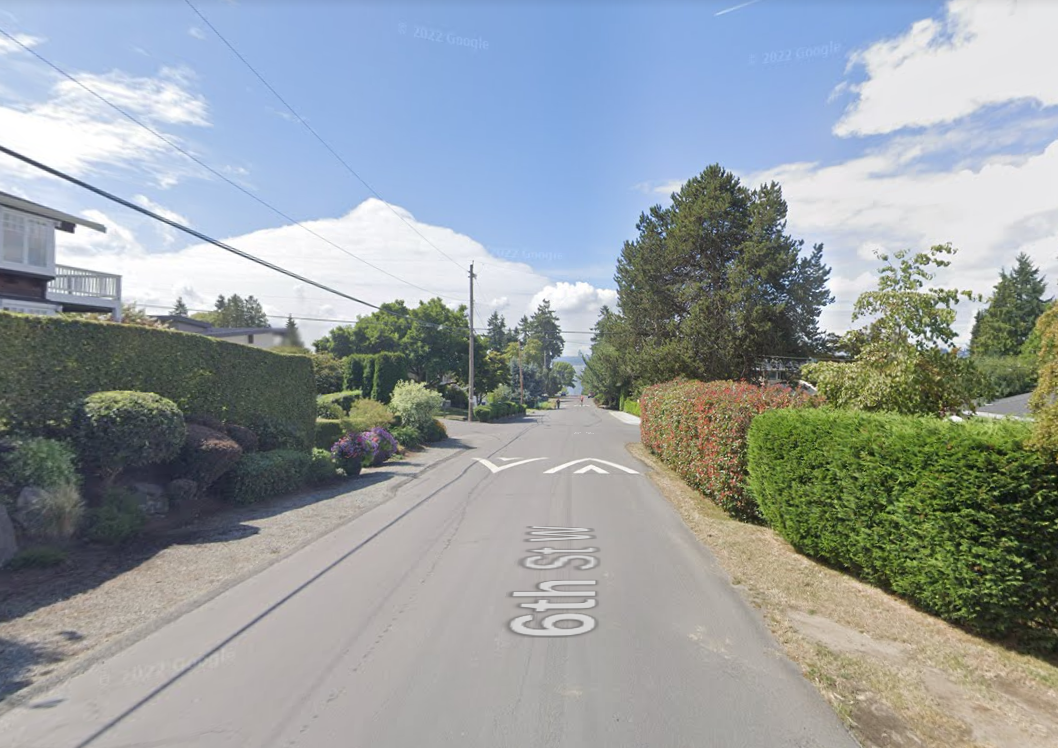
Following the adoption of the Active Transportation plan earlier this year, some projects from that plan were added to the mix. The $21 million project list is now planned as 64% new sidewalks, 19% new and enhanced crosswalks, 14% for bike improvements and 3% for street maintenance. That translates to around 16 sets of upgraded crosswalks, 10 sets of new sidewalks, and repairs on seven more sets of sidewalks happening within six years.
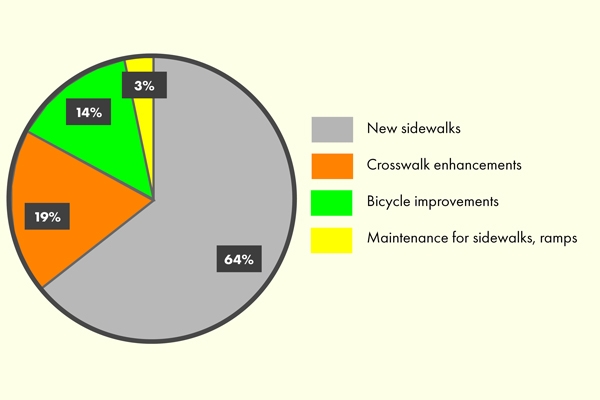
But the approximately $3 million planned to cover improvements to improve the city’s bike network mostly consists of adding green “conflict paint” to existing paint only bike lanes, a move that won’t build on Kirkland’s limited plans to build protected bike infrastructure elsewhere in the city.
Advocates are trying to push the city to take another look at adding a few critical protected bike lanes instead. At the first public forum on the proposal last week, Kirkland Greenways member Chris Kagan identified safety as the primary reason they should make this shift.
“I would encourage staff to focus on protected bike lanes where possible,” he said. “I would prefer to see a smaller number of projects with a larger index of safety. The city has a little bit of propensity for laying down white paint and calling that bicycle improvement, and that does not encourage the average person to get out and bicycle more.”
The City of Kirkland is making moves to become more bike friendly, which makes this potential missed opportunity all the more striking.
Kirkland’s bike network slowly comes together

The spine of Kirkland’s bike network is the Cross Kirkland Corridor. Providing an off-street connection between major swaths of Kirkland, the CKC is a key segment of the planned EasTrail corridor that will ultimately connect the city with many other parts of the region as the planned trail network is built out. Through Kirkland the path is gravel, and until recently the hours of operation for the trail were only dawn to dusk. This year, those hours were changed to 5am to 11pm, with a 24/7 trail discarded over concerns around noise and use by people who are living unsheltered. Of course, any operating hours for a safe and protected route creates the potential for people to use less safe routes outside those hours: the Kirkland City Council adopted those operating hours against the recommendation of groups like the Cascade Bicycle Club.
Under construction right now is a $22.3 million bicycle and pedestrian bridge that fills a key gap in the CKC, crossing the daunting roadways that are NE 124th Street and Totem Lake Boulevard. The Totem Lake Connector, as the bridge is called, is expected to open next year, and will further solidify the role that the Cross Kirkland Corridor serves as a regional trail connection and as a multimodal option for travel within Kirkland. But protected facilities on arterial streets in the city are largely missing from future plans.

Kirkland is also in the process of adding protected bike lanes to 124th Avenue NE, creating a direct connection from the new pedestrian bridge south to NE 116th Street, a key east-west bike route. But like many cities around the region, Kirkland is only making room for protected bike facilities by widening the entirety of 124th Avenue from three to five lanes. On 116th, the planned transportation benefit district will just add green paint, and bike riders heading around Juanita Bay will still have to contend with the bike lane disappearing near the intersection at 98th Avenue NE. The same thing happens with bike lanes on Forbes Creek Drive and 108th Avenue NE.

Intersections like those are a big reason that the city’s Active Transportation plan noted that the city’s existing bike network “is mostly for ‘enthused and confident’ bicyclists.” There are a few additional protected bike lanes planned by the city but even with a new dedicated funding source, a fully separated network connecting people biking with amenities on arterial streets is a very long way off at the current pace.
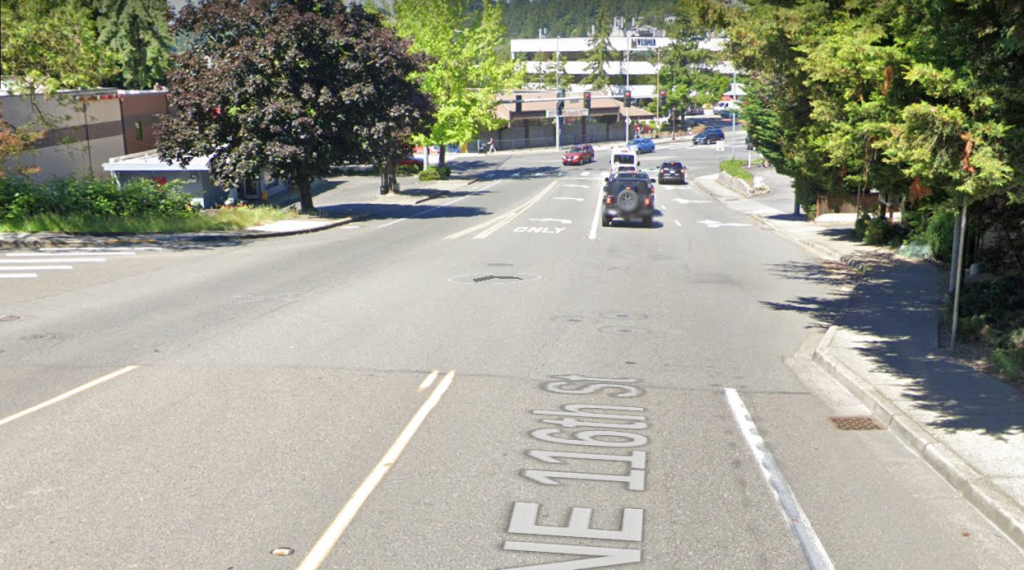
Lake Washington Boulevard promenade

There is another potential project on the horizon that could change the game for bike travel in Kirkland. The city has been studying the potential of creating a walking and biking promenade along Lake Washington Boulevard NE, which is the same street as Lake Street S close to Downtown Kirkland. Connecting several waterfront parks, the promenade would upgrade a section of the signed Lake Washington loop route. A number of possible alternatives are on the table, including an expanded sidewalk or an on-street protected bike lane.
Unlike the section of Seattle’s Lake Washington Boulevard being considered for improvements, much of Kirkland’s Lake Washington Boulevard faces private properties rather than open shoreline, but the corridor is still highly used as a walking and biking route. The issue will be how acceptable it is to remove parking along the stretch, and how close the promenade will get to Downtown Kirkland. Currently the paint bike lanes disappear as you approach Downtown, as the street transitions to a calmer “shared street”, exemplified by the future Lake Street pedestrian scramble at Kirkland Avenue. But creating an all-ages bike network will require dedicated bike facilities downtown as well.
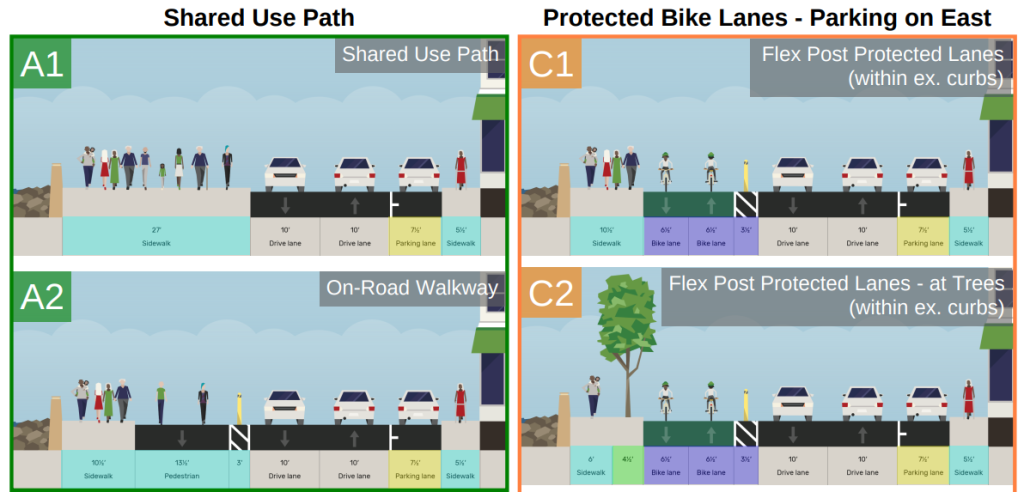
Kirkland’s transportation commission is poised to get a more detailed assessment of the different options for the promenade by the end of the year. But improvements along that corridor are still largely unfunded.
Adding the entirety of the new $20 Vehicle License Fee toward safety improvements for people walking and biking signals that Kirkland is more committed than many other cities around the region to improving access for people outside cars, particularly kids going to and from school. Ensuring those improvements go as far as possible in improving the all-ages-and-abilities bike network in Kirkland will be critical.
Ryan Packer has been writing for The Urbanist since 2015, and currently reports full-time as Contributing Editor. Their beats are transportation, land use, public space, traffic safety, and obscure community meetings. Packer has also reported for other regional outlets including Capitol Hill Seattle, BikePortland, Seattle Met, and PubliCola. They live in the Capitol Hill neighborhood of Seattle.



